Serviços Personalizados
Journal
artigo
Indicadores
Compartilhar
Interamerican Journal of Psychology
versão impressa ISSN 0034-9690
Interam. j. psychol. v.40 n.2 Porto Alegre ago. 2006
ARTÍCULOS
Sustainable behavior and time perspective: present, past, and future orientations and their relationship with water conservation behavior
Conducta sostenible y perspectiva temporal: 0rientaciones al presente, pasado y futuro y su relación con la conducta de ahorro de agua
Víctor Corral–Verdugo1,2, I; Blanca Fraijo–SingI; José Q. PinheiroII
I Universidad de Sonora, Hermosillo, Mexico
II Universidade Federal do Rio Grande do Norte, Natal, Brazil
ABSTRACT
Three hundred individuals at a Mexican city responded to Zimbardos Time Perspective Inventory (ZTPI), and self–reported how frequently they engaged in water conservation practices. The ZTPI assesses individual differences in terms of attitudes believed to identify orientations towards a positive or negative past, hedonistic or fatalistic present, and future orientations. Results were processed within two structural equation models, which showed that present orientation negatively affected water conservation. Water conservation did not correlate with past orientation. Yet, that pro–environmental behavior significantly and positively was influenced by Future Orientation. Women reported a higher involvement in water conservation practices, whereas adult individuals (> 18 years old) and those with higher schooling levels presented a higher Future Orientation. Proposals considering these results are discussed aimed at developing sustainable attitudes and behaviors.
Keywords: Time perspective, Conservation (ecological behavior), Hermosillo (Mexico).
RESUMEN
Trecentos mexicanos contestaron a los reactivos del Inventario de Perspectiva Temporal de Zimbardo (IPTZ) y auto–reportaron sus conductas de ahorro de agua. El IZPT mide diferencias individuales en términos de orientaciones hacia un pasado positivo o negativo, un presente fatalista o hedonista y tendencia hacia el futuro. Los resultados se procesaron en dos modelos de ecuaciones estructurales, revelando que la orientación al presente afecta negativamente al ahorro de agua. Este ahorro no se correlacionó con la orientación al pasado, pero sí lo hizo positivamente con la orientación al futuro. Las mujeres reportaron ahorrar más agua, mientras que los adultos (> 18 años) y las personas de mayor escolaridad se plantearon con una mayor orientación hacia el futuro.
Palabras clave: Percepción del tiempo, Conservación (conducta ecológica), Hermosillo (México).
This paper explores the relationship between peoples time perspective and their tendency towards a responsible and sustainable use of natural resources. One of the most important aspects characterizing sustainable behavior is its extended temporal component since it includes – on the one hand – a concern for upcoming times and for future generations (Joreiman, Van Lange, & Van Vugt, 2004). This concern considers the possibility that already unborn individuals could take advantage of natural resources, as much as present generations do (Pinheiro, 2002a, 2002b). On the other hand, some studies suggest that presentoriented individuals sometimes tend to engage in both antisocial and anti–environmental actions. Since antienvironmental actions could be instances of antisocial behavior (Corral–Verdugo, Frías, & González, 2003) and antisocial people seem to exhibit a tendency to living the present without a concern for the future (Harvey & Micceli, 1999), such a present orientation could constitute an indicator of behaviors opposing sustainability. If – as those studies suggest – future orientation is linked to sustainability and present orientation is one indicator of antienvironmental tendencies, thus, investigating time orientation could be a fruitful strategy in the search for predictors of sustainable behavior.
Zimbardo and Boyd (1999) proposal is one of the few conceptions of a psychological dimension of time to be considered as a profile of sustainable behavior. According to this conception, time perspective is one fundamental dimension in the construction of psychological time, which includes those cognitive processes classifying human experience in past, present and future compartments. These authors consider that time perspective is learned and modified by personal, social and institutional factors. Their perspective tackles a strong – yet little studied – influence on diverse facets of human behavior (Keough, Zimbardo, & Boyd, 1999), as the ones they have investigated (i.e., risky car driving, drug consumption, among others).
The notion of time perspective has been correlated with a number of psychological and sociological concepts. This notion refers to individuals ability to anticipate future events and to reflect him/her in the past and in the present (Lennings & Burns, 1998). Keough, et al. (1999) suggest that time perspective is an unconscious process in which the continuum happening of social and personal events is distributed in temporal classes to provide order, coherence and meaning. Such temporal frameworks –past, present and future – help in codifying, storing and evoking experienced situations, goals, contingencies, and imagined contexts. The time perspective of these authors assumes a kind of perception that integrates the distinct instants of time within
In theory, a balanced time perspective contributes to an alternated use of time orientations, in accordance with its pertinence to each occasion. Therefore, people sometimes are present–oriented, while in other times they tend to the future or the past. However, many individuals mainly use a particular orientation, so that they exhibit a bias in their time perspective. For example, those who have a present orientation have the ability to enjoy the moment, without being distracted by past difficulties or by future concerns. They are incapable of both delaying gratification and defining ways towards reasonable goals. In addition it is likely that they do not pay attention to warnings signaling that their actual behavior could have negative effects on the future. Others are past–oriented in the sense that they enjoy remembering positive events they experienced before, or are constantly disturbed by negative experiences of their past. In turn, those with a marked future orientation are good in establishing and achieving goals and in planning strategies for meeting long–term obligations. Also, these future–oriented people tend to avoid engaging in risk behaviors, given their ability to prevent negative consequences in the future. Moreover, futureoriented individuals visualize and formulate future objectives, which will influence present decisions and judgments (Keough, et al. 1999). The question is whether or not the time perspective of people could influence their propensity to behave in an environmentally responsible way.
A sustainable way of life requires, in theory, a propensity for the future. Anticipating the consequences of own behavior, and a long–term thinking are characteristic of individuals concerned with the status of the environment. Realizing that current actions have consequences not only on the individual, but on others as well, should be conducive to sustainable behaviors (Pinheiro, 2002a). Responsibility, internal locus of control, morality, and altruism are correlates of future orientation, and, coincidently, environmentally concerned persons also exhibit these personal characteristics (Allen & Ferrand, 1999; Biaggio et al., 1998; Guagnano, 1995). On the contrary, a shortterm thinking and its associated traits (tendency to antisociality, and proneness to risk taking) are expected to predominate in present–oriented individuals (Rushton, 1985) and in antienvironmental persons (Corral–Verdugo, Frías, et al. 2003). Past orientation would not be particularly related to either pro–environmentally or anti–environmentally tendencies – unless such a past include salient memories and experiences from contacts with the environment (see Chipeniuk, 1995, for instance). The positive features of future propensity (anticipation, planning, and responsibility) and the negative aspects of present orientation (proneness to risk taking, impulsiveness) are not components of this (past) time perspective.
There are a limited number of studies investigating the relationship between time perspective and sustainability. Lindsay and Strathman (1997) reported that consideration of future consequences (CFC) (i.e., the weight attached to immediate vs. delayed consequences of ones actions) made people more likely to engage in consumer behavior that benefits the environment. Also, Joireman, et al. (2001) found that individuals scoring high in CFC reported more willingness to fund improvement in public transit. According to these studies, the consideration of future consequences made people more convinced of and affected by the longterm benefits of their sustainable behavior. A more recent study by Joreiman, et al. (2004) indicated that higher scores in CFC correlated with preference for commuting to work by public transportation (instead of by car). These authors concluded, A future orientation may be more important than a pro–social orientation in shaping commuting preferences (p. 188). No study considering the relationship of present and past perspectives with sustainable behavior is detected in the literature. As formerly indicated, few studies have been conducted considering the link between future orientation and pro–environmental actions. Thus, the purpose of this study was to investigate how water conservation is related to past, present and future orientations
Water conservation is one significant instance of sustainable behavior. Previous studies have shown that factors such as motivational variables are instigators of water conservation. The more motives a person has for saving this resource, the more he or she conserves water (López, Balboa, Igartúa, & Claramunt, 1994). Perceptual factors are also important in explaining either waste or conservation of this liquid. The individuals perception regarding the value of their gardens was a positive predictor of water consumption, according to Syme, Thomas and Salerian (1983). In turn, De Oliver (1999) found that the perception of others engaging in an obligatory campaign of water conservation led people to cooperate with the required conservation effort. Conservation skills are also predictors of this sustainable behavior (Corral–Verdugo, 2002; Middlestadt et al., 2001), and ecological beliefs also seem to predispose people to a rational use of this natural resource (Corral–Verdugo, Bechtel, & Fraijo, 2003). Our task was to identify whether or not time perspective has a role in modifying or directing water conservation effort. The research hypotheses were: 1) Present orientation will negatively affect water conservation. The more a person has a propensity for the present the less her⁄his proenvironmental effort. 2) Future orientation will positively affect water conservation. The more the propensity for the future, the more the sustainable behavior exhibited by the individual. 3) Past orientation will have no effect on water conservation. This proenvironmental behavior will be practiced regardless of the past–orientation level of the persons. 4) Although sociodemographic variables, such as gender, education, and age will have an impact on water conservation, their influence will not attenuate the effect of time perspectives on that sustainable behavior.
Method
Participants
Three hundred individuals (160 females, 140 males) from the city of Hermosillo, Mexico participated in this study. They were selected from zones of that city that, according to the Mexican Census Office (INEGI, 2000) were representative of high, middle, and low socio–economic classes. Households were randomly selected from each zone. The zones were selected and maps of these neighborhoods were obtained from local authorities. The selection of households involved the use of these maps in which every premise was represented. All premises were assigned a number, and a list of random numbers was used to select 100 households. 50% of them were low –class homes, while 40% constituted middle–class homes and the additional 10% were high–class households. The individuals investigated in each home were the housewives, a male adult, and a young man/woman aged 12–18 years old. The age mean for the total sample was 31.8 (SD=13.3) years. 46% of them reported a family monthly income between 0 and 600 U.S. dollars, 26% had an income between 600 and 2000 dollars and only 15% reported earnings between 2000 and more than 3000 dollars per month. The mean of educational level for this sample was 11.9 (SD=4.9) completed grades at school. Since a third part of the sample was constituted by adolescents, the distributions of age and schooling are presented separately, for adults and younger respondents, on Table 1, showing a clearer picture of these distributions.
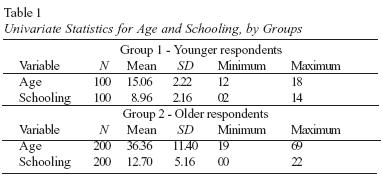
Instruments
The Zimbardos Time Perspective Inventory (ZTPI, Zimbardo & Boyd, 1999) was utilized for this study. The ZTPI purportedly assesses individual differences in terms of attitudes believed to identify persons of past, present or future orientation. According to Zimbardo, this inventory identifies tendencies towards a Hedonistic Present (living present life in enjoyment), a Fatalistic Present (perceiving own life under the control of external events), a Positive Past (an orientation towards pleasant past memories), a Negative Past (living a past of unpleasant and painful events), and Future Orientation (the tendency to planning and anticipating events). We administered a Spanish version of the entire set of (56) items constituting the ZTPI. Items of this inventory are assessed on a 5–point Likert scale; according to how characteristic each statement is of the respondent. In turn, water conservation was self–reported as the frequency with which the respondent engaged in actions such as conserving water while washing dishes, brushing teeth, or washing their car(s) during the last week. Finally, participants were asked to provide demographic information, including age, family monthly income, and schooling.
Procedure
Participants were approached and their informed consent to participate in this study was obtained. Everyone accepted to respond to the instruments. Both the ZPTI and the water conservation items were administered in the households living room. It took about 20 minutes to respond to these instruments.
Data Analysis
Cronbachs alphas, as well as univariate statistic for each scale and their items were obtained. Those alphas were considered to indicate internal consistency (reliability) of every scale. A structural equations model (SEM) was specified in orderto test both the factor structure of the ZTPI and the effect of time perspectives on water conservation. Items of the ZPTI were parceled into three indicators per tested construct (hedonistic present, fatalistic present, negative past, positive past and future orientation). A parcel is the mean or two or more randomly chosen items of a construct. In this case, we randomly distributed the total number of items corresponding to each factor into three indicators. Since both types of present orientation (hedonistic, fatalistic) were highly and significantly correlated (r= .75, p< .0001) as well as positive past and negative past were (r= .72, p< .0001), we decided to specify simple present and past constructs, by collapsing the items of fatalistic and hedonistic present in three parcels for a single factor (present orientation). Also, three parcels from the combined items of negative and positive past orientation were computed for a simple past orientation construct.
As it is known, a SEM contains two identifiable models: the measurement model and the structural model. The first one is basically a Confirmatory Factor Analysis (CFA) in which the relations between every factor and their supposed observed variables are specified (Bryant & Yarnold, 1998), and the validity of these relations is tested. High and significant lambdas (i.e., factor loadings) are indicators of convergent construct validity for the assessed factors. In turn, the structural model contains the relations between factors as well as the relations between manifest variables and latent factors.
In addition, goodness of fit indicators (chi–squared, practical goodness of fit indices, RMSEA, etc.) reveal whether or not the data support the adequacy of the hypothesized factor structure and the pattern of presumed interrelations between factors (Bentler, 1995). Four factors were pre–specified within a first SEM to be tested. These were the three time dimensions (present, past, and future orientations) and the water conservation factor. In this first model, the three time–perspective factors were specified as predictors of water conservation. A second SEM was specified and tested in order to control for the sociodemographic covariates (age, gender, income, and schooling) effect, and to see whether or not the addition of these covariates affected the goodness of fit of the previous model. In this second model, age and gender were included as manifest predictors of water conservation along with the tree time–orientation factors and an additional latent variable representing Socio–Economic Status (SES), which was specified as resulting from the correlation between income and schooling. A constraint was imposed in specifying this SES factor, due to our using the minimum number of indicators (two) required to produce a latent variable.
In order to correlate results of the four scales with the participants demographic information, indices representing those scales were computed. Every index was computed from averaging the responses to items of every scale. Then, Pearsons correlation coefficients were obtained to indicate the relationship between those indices and the demographic variables. In addition, differences between demographic groups (gender, age) in terms of time perspectives were assessed, as well as regarding to water conservation practices.
Results
Table 2 shows univariate statistics and reliability indicators of scales used in this study. Cronbachs alphas of .80, .77, .75,and .62 were computed from the present, past, future and water conservation scales. Means of these scales reveal that the highest levels of adherence to time perspective items were for future orientation (mean=3.42) and past propensity (mean=3.16), followed by present orientation (mean=3.01). The water conservation scale produced a mean of 7.27 times participants engaged in water saving actions in the last week.
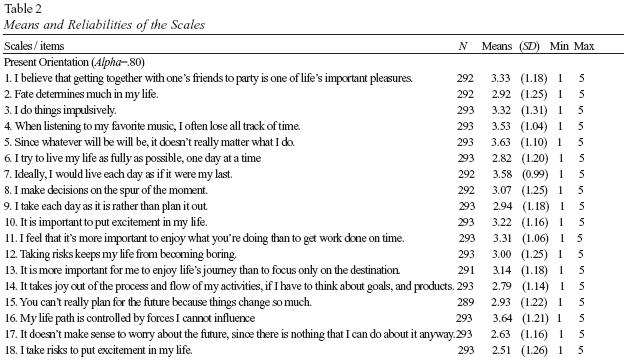
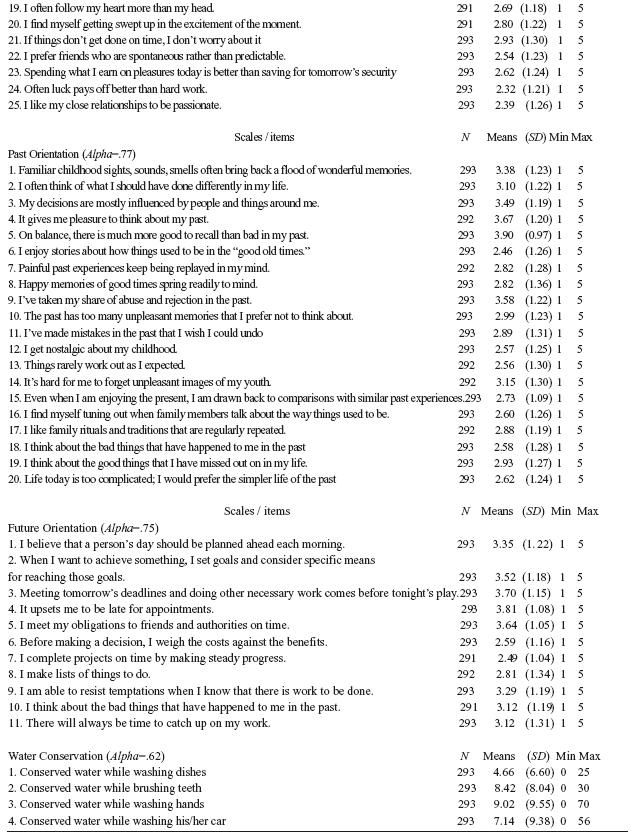
Figure 1 exhibits the results of the first SEM, presenting the tested factorial structure for the three time dimensions and the water conservation factor. All lambdas are significant (p< .05), revealing convergent construct validity for the specified factors. Since the values of the covariances between factors are lower than the values of those lambdas, this indicates divergent (discriminant) convergent validity. Present and past orientation produced a .19 covariance; past and future orientations had a .59 correlation; while the present and future dimensions did not correlate. Present orientation negatively and significantly affected water conservation (structural coefficient= –.20; p< .05), the past dimension did not influence this sustainable behavior, and future orientation affected it with a significant, and positive structural coefficient (.36; p< .05). Goodness of fit indicators for this first SEM are presented in the bottom of Figure 1. Although the p associated to the statistic indicator Chisquared resulted significant, the values of NNFI and CFI were equal to or higher than .90, and the RMSEA value was = .06, indicating that the data supported the specified model (see Bentler, 1995).
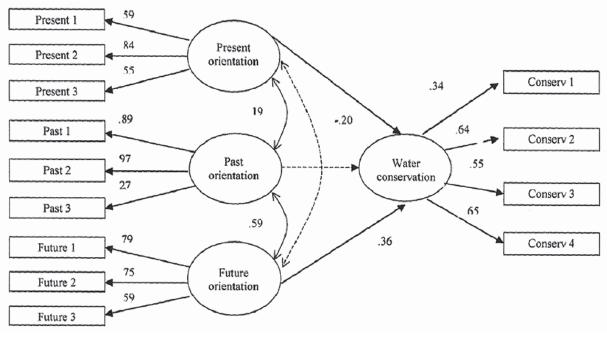
Figure 1. Structural model of water conservation predicted by present, past and future orientations. Rectangles indicate manifest variables, while ovals are latent factors. Dotted lines represent non–significant relations. Goodness of fit: X2= 125.5 (56 df), p<.001; NNFI=.92, CFI= .94, RMSEA=.06. R2=.14
Figure 2 exhibits the patterns of interrelation among the time–orientation factors, the sociodemographic variables and water conservation, within the second SEM. The measurement model repeats the findings of the factor structure of model 1 for the past, present, and future orientation constructs, and for the water–conservation latent variable. In addition, it produces the SES factor, indicated by high and significant lambdas from the income and schooling variables to their latent factor. The only significant covariances (p< .05) produced from the time perspective dimensions and the socio–demographic indicators resulted from future orientation and age (.26), future orientation and SES (.28) and age and past orientation (.17). The structural model shows, again, that present orientation negatively affects water conservation, the future perspective influences this sustainable behavior in a positive way, and past orientation has no significant effect. SES did not affect water conservation, but significant and positive structural coefficients from age (.22, p< .05) and from gender (.14, p< .05) to that proenvironmental behavior resulted, indicating that adults and women were more conservationist than younger and male respondents. The statistical and practical indicators reveal a slight decrease in goodness of fit in this second model, as compared with the first one (see Figure 2). Adding the socio–demographic indicators did not notoriously affect the influence of the time perspective factors on water conservation.
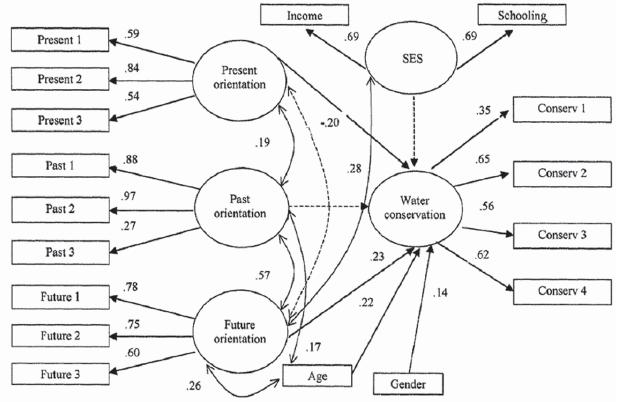
Figure 2. Structural model of water conservation predicted by time orientations and socio–demographic variables. Goodness of fit: X2= 228.8 (97 df), p<.001; NNFI=.87, CFI= .91, RMSEA=.07. R2=.18.
Additional analyses revealed significant differences between demographic groups in terms of some time perspectives, as well as regarding to water conservation practices. Women reported a higher involvement in water conservation practices than men did. Adult individuals (> 18 years old) presented a higher future orientation; they tended to be also more past oriented and reported being more engaged in water conservation behaviors than the younger did (See Table 3). A significant correlation resulted between schooling and future orientation (r=.37, p< .0001).
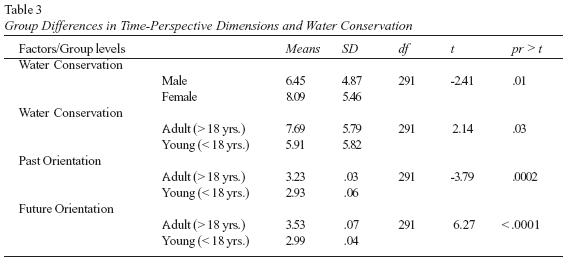
Discussion
Results of this study seem to show that peoples time perspectives affect their commitment to act in a proenvironmental way. As our first structural model showed, future–oriented individuals reported a higher engagement in water conservation actions, while the more present–oriented tended to be less conservationists. Past orientation did not affect this pro–environmental effort. These results supported the hypotheses regarding a differential influence of present, past and future perspectives on peoples environmental behavior. Future orientation is a component in the definition of sustainability, which is conceived as a lifestyle that meets present human needs without compromising the needs of the future (Brundtland Comission, 1987). A pro–environmentally committed person organizes his/her life by planning, anticipating consequences, and meeting duties and obligations (Allen & Ferrand, 1999; Pinheiro, 2002b) Conversely, as our data showed, individuals who are mostly inclined to enjoy the present or that are fatalistic in their perceiving that their life is under the control of external events, are not distracted by the future and are more prone to use natural resources here and now without feeling concerned for the status of the environment (see also Guagnano, 1995; Harvey & Miccelli, 1999). According to the literature, the short–term thinking characteristic of present–oriented individuals seems to predominate in both antisocial and anti–environmental persons (Corral–Verdugo, Frías, et al. 2003). Since this time limitation makes difficult the anticipation of actual behavior consequences in the future, it is possible that present orientation might predispose people towards a wasteful use of environmental resources.
Past orientation did not correlate with water conservation. Participants in this study reported diverse levels of conservation behavior regardless of their propensity for the past. Unlike future orientation – which compels individuals to anticipate consequences of their own behavior – and present orientation – that make people prone to enjoying the immediate use of natural resources – past orientation would not make persons especially interested in either the conservation or the misuse of water.
Including the socio–demographic covariates of SES, age, and gender, in a second SEM, did not significantly modify the influence of present and future orientations on water conservation. This seems to indicate that time perspective affects sustainable behavior regardless of the sociodemographic characteristics of individuals. Yet, age and gender also influence water conservation: older people and women were more inclined to conserve water.
The comparisons between groups as well as the significant correlations resulting between demographic variables, time perspectives and sustainable behavior were also illustrative. Females were more involved in water conservation behaviors than males. This result is consistent with past reports from the conservation behavior literature (Dietz, Stern, & Guagnano, 1998; Mainieri, Barnett, Valdero, Unipan, & Oskamp, 1997; Tanner, 1999) indicating that women are more pro–environmentally oriented than men. Also, in accordance with previous research and theory (Coleman, 1990; Nurmi, Pullianen, & Salmela–Aro, 1992), adult individuals presented a higher future orientation and reported a higher involvement in water conservation practices. Since future orientation develops as a function of maturity (Nurmi, et al., 1992) these results would be indicating that a deficit in future orientation could delay the development of a sustainable way of life.
The positive and significant correlation between schooling and future orientation might be pointing out at the beneficial effect that education has on these time perspectives. The school experience helps in inducing maturation, planning capacities, and responsibility. Thus, according to our results, providing education opportunities could be an adequate strategy in promoting the traits that are characteristics of a future–oriented person.
This study presents some limitations that should be addressed in further explorations of the relationship between time perspective and sustainability. The assessment of sustainable behavior was self–reported, which limits its validity. People usually self–report more engagement in proenvironmental actions than they actually do. Therefore, alternative ways of measuring this kind of behaviors should be used in future studies, combined with self–reports, to guarantee the expected validity. A larger sample of participants would also be recommendable.
What are the possible applications of these findings? Two possibilities are appealing: First, since future orientation and sustainable behavior appears to be significantly related, a recommended strategy to promote the conservation of natural resources is the induction of a more future–oriented perspective among citizens. Future orientation is a function of socialization, maturation and aging. Children develop the capacity to anticipate events as they approach adulthood (Coleman, 1990; Nurmi et al., 1992), which does not mean that they are not able to exhibit future–oriented traits. Therefore, educational programs that include the acquisition of time–administration skills, the training in planning tasks, in combination with the development of social norms and values could be a fruitful strategy in developing a future–oriented perspective and, subsequently, a proenvironmental commitment. Second, since education is positively correlated with future orientation, making accessible educational opportunities to people will result in an increased future orientation and pro–environmental effort. A known fact in Conservation Psychology is that education promotes sustainable actions (Dietz et al. 1998; Scott & Willits, 1994). Unfortunately, in Latin America countries, poverty constitutes a formidable barrier to overcome in attempting to provide educational opportunities (especially in high school and above) to everybody. Of course, more research is needed in order to confirm the findings of this study and its possible contributions to the understanding of sustainable behavior.
References
Allen, J. A., & Ferrand, J. L. (1999). Environmental locus of control, sympathy and proenvironmental behavior. Environment & Behavior, 31, 338–353.
Bentler, P. M. (1995). EQS. Structural Equations Program Manual. Encino, USA: Multivariate Software. [ Links ]
Biaggio, A., Medeiros, M., Vargas, G., Monteiro, J., Plitzko, G., Souza, L., et al. (1998). Julgamento moral e maturidade de atitude em relação à ecologia. Interamerican Journal of Psychology, 32, 33–52.
Brundtland Comission (1987). Our common future. Oxford, UK: Oxford University Press. [ Links ]
Bryant, F., & Yarnold, P. (1998). Principal–components analysis and exploratory and confirmatory factor analysis. In L. Grimm & P. Yarnold (Eds.), Reading and understanding multivariate statistics (pp. 99–136). Washington, DC, USA: American Psychological Association.
Chipeniuk, R. (1995). Childhood foraging as a means of acquiring competent cognition about biodiversity. Environment & Behavior, 27, 490–512.
Coleman, J. (1990). The nature of adolescence. London, UK: Routledge. [ Links ]
Corral–Verdugo, V. (2002). A structural model of pro–environmental competency. Environment & Behavior, 34, 531–549.
Corral–Verdugo, V., Bechtel, R. B., & Fraijo, B. (2003). Environmental beliefs and water conservation: An empirical study. Journal of Environmental Psychology, 23, 247–257.
Corral–Verdugo, V., Frías, M., & González, D. (2003). On the relationship between antisocial and anti–environmental behaviors: An empirical study. Population and Environment, 24, 273–286.
De Oliver, M. (1999). Attitudes and inaction: A case study of the manifest demographics of urban water conservation. Environment & Behavior, 31, 372–394.
Dietz, P., Stern, P., & Guagnano, G. A. (1998). Social structure and social psychological bases of environmental concern. Environment & Behavior, 30, 450–471.
Guagnano, G. A. (1995). Locus of control, altruism and agentic disposition. Population and Environment, 17, 63–77.
Harvey, M. G., & Miceli, N. (1999). Antisocial behavior and the continuing tragedy of the commons. Journal of Applied Social Psychology, 29, 109–138.
INEGI. (2000). Estados Unidos Mexicanos. Principales resultados por localidad. XII Censo General de Población y Vivienda. Mexico, DF: Autor. [ Links ]
Joreiman, J. A., Van Lange, P. A., & Van Vugt, M. (2004). Who cares about the environmental impact of cars? Those with an eye toward the future. Environment & Behavior, 36, 187–206.
Joireman, J. A., Van Lange, P., Van Vugt, M., Wood, M., Vander Leest, T., & Lambert, C. (2001). Structural solutions to social dilemmas: A field study on commuters willingness to fund improvements in public transit. Journal of Applied Social Psychology, 31, 504–526.
Keough, K., Zimbardo, P., & Boyd, J. (1999). Who is smoking, drinking, and using drugs?: Time perspective as a predictor of substance use. Basic and Applied Social Psychology, 21, 149– 164.
Lennings, C., & Burns, A. (1998). Profiles of time perspective and personality: Developmental considerations. The Journal of Psychology, 132, 629–64.
Lindsay, J. J., & Strathman, A. (1997). Predictors of recycling behavior: An application of a modified health belief model. Journal of Applied Social Psychology, 27, 1799–1823.
López, E., Balboa, H., Igartúa, A., & Claramunt, R. (1994). Aproximación al estudio de actitudes respecto al ahorro doméstico de agua en Barcelona. In B. Hernández, E. Suárez, & J. Martínez–Torvisco (Eds.), Interpretación social y gestión del entorno: Aproximaciones desde la psicología ambiental (pp. 29–34 ). San Cristóbal de la Laguna: Universidad de La Laguna, España.
Mainieri, T., Barnett, E., Valdero, T., Unipan, J., & Oskamp, S. (1997). Green buying: The influence of environmental concern on consumer behavior. The Journal of Social Psychology, 13, 189–204.
Middlestadt, S., Grieser, M., Hernández, O., Tubaishat, K., Sanchack, J., Southwell, J., et al. (2001). Turning minds on and faucets off: Water conservation education in Jordanian schools. Journal of Environmental Education, 32, 37–45.
Nurmi, J. E., Pullianen, H., & Salmela–Aro, K. (1992). Age differences in adults control beliefs related to life goals and concerns. Psychology and Aging, 7, 194–196.
Pinheiro, J. Q. (2002a). Apego ao futuro: Escala temporal e sustentabilidade em Psicologia Ambiental. In V. Corral–Verdugo (Ed.), Conductas protectoras del ambiente. Teoría, investigación y estrategias de intervención (pp. 29–48). Ciudad de Mexico: CONACYT–UniSon.
Pinheiro, J. Q. (2002b). Comprometimento ambiental: perspectiva temporal e sustentabilidade. In J. Guevara & S. Mercado (Eds.), Temas selectos de psicología ambiental (pp. 463–481). México, DF: UNAM.
Rushton J. P. (1985). Differential K theory: The sociobiology of individual and group differences. Personality & Individual Differences, 6, 441–452.
Sccott, D., & Willits, F. K. (1994). Environmental attitudes and behavior: A Pennsylvania survey. Environment & Behavior, 26, 239–260.
Syme, G., Thomas, J., & Salerian, S. (1983). Can household attitudes predict water consumption? In Hidrology and Water Resources Symposium (pp. 53–56). Canberra, Australia: Institution of Australia Engineers.
Tanner, C. (1999). Constraints on environmental behaviour. Journal of Environmental Psychology, 19, 145–157.
Zimbardo, P. G., & Boyd, J. N. (1999). Putting time in perspective: A valid, reliable individual–differences metric. Journal of Personality and Social Psychology, 77, 1271–1288.
Received 01/10/2005
Accepted 23/01/2006
1 Address: Sevilla 6 Residencial Casa Grande 3, Hermosillo, Sonora, 83240 Mexico.
E-mail: victorcorral@sociales.uson.mx.
2 Mexico’s National Council of Science and Technology (CONACYT, Grant 36683-H) funded this study.
Victor Corral–Verdugo. Obtained his Ph.D. in Environmental Psychology at the University of Arizona, USA. He is currently a professor at the University of Sonora, Hermosillo, Mexico, where he teaches and conducts research on determinants of sustainable behavior, structural modeling, and environmental education. Dr. Corral-Verdugo is the head of the Environmental Psychology Comission at the Interamerican Society of Psychology, as well as an international associate editor of the journal Environment & Behavior.
Blanca Fraijo-Sing. Doctor in Social Sciences by the University of Sinaloa, Mexico, is associate professor of psychology at the University of Sonora, Hermosillo, Mexico. In 2005 she was awarded with the Interamerican Prize of Environmental Psychology in the category of student productivity. Her areas of interests are Environmental Education and predictors of pro-environmental behavior in children.
Jose Q. Pinheiro. Obtained his Ph.D. in Environmental Psychology ate the University of Arizona, USA. He is a
professor at the Department of Psychology, Universidade Federal do Rio Grande do Norte, Natal, Brazil. His main
areas of research are cognitive maps, time perspective as a correlate of pro-ecological behavior, and determinants of pro-environmental commitment. Dr. Pinheiro has been head of the Environmental Psychology Comission at the Interamerican Society of Psychology. He is currently the president of the Latin American Network of Environmental Psychology and Editor of the journal Estudos de Psicologia.












 Curriculum ScienTI
Curriculum ScienTI
